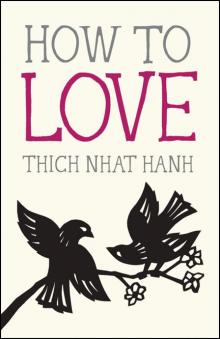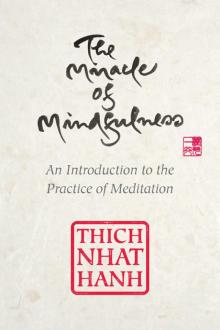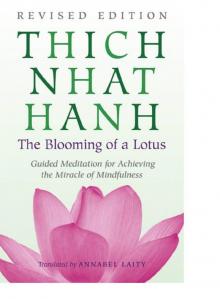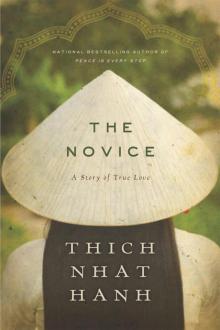- Home
- Thich Nhat Hanh
The Miracle of Mindfulness (Gift Edition) Page 2
The Miracle of Mindfulness (Gift Edition) Read online
Page 2
But what is the purpose of the Sutra’s instruction? Where are we to find the time to practice such mindfulness? If you spend all day practicing mindfulness, how will there ever be enough time to do all the work that needs to be done to change and to build an alternative society? How does Allen manage to work, study Joey’s lesson, take Ana’s diapers to the laundromat, and practice mindfulness at the same time?
1 In the Sutras, Buddha usually teaches that one should use one’s breath in order to achieve Concentration. The Sutra which speaks about the use of your breath to maintain mindfulness is the Anapanasati Sutra. This Sutra was translated and commentated on by a Vietnamese Zen Master of Central Asian origin named Khuong Tang Hoi, around the beginning of the Third Century A.D. Anapana means breath and sati means mindfulness. Tang Hoi translated it as “Guarding the Mind.” The Anapanasati Sutra, that is, is the sutra on using one’s breath to maintain mindfulness. The Sutra on Breath to Maintain Mindfulness is the 118th Sutra in the Majjhima Nikaya collection of sutras and it teaches 16 methods of using one’s breath.
TWO
The Miracle Is to Walk on Earth
Allen said that since he’s begun to consider Joey’s and Sue’s time as his own, he has “unlimited time.” But perhaps he has it only in principle. Because there are doubtless times when Allen forgets to consider Joey’s time as his own time while going over Joey’s homework with him, and thus Allen may lose that time. Allen might hope for the time to pass quickly, or he may grow impatient because that time seems wasted to him, because it isn’t his own time. And so, if he really wants “unlimited time,” he will have to keep alive the realization that “this is my time” throughout the time he’s studying with Joey. But during such times, one’s mind is inevitably distracted by other thoughts, and so if one really wants to keep one’s consciousness alive (from now on I’ll use the term “mindfulness” to refer to keeping one’s consciousness alive to the present reality), then one must practice right now in one’s daily life, not only during meditation sessions.
When you are walking along a path leading into a village, you can practice mindfulness. Walking along a dirt path, surrounded by patches of green grass, if you practice mindfulness you will experience that path, the path leading into the village. You practice by keeping this one thought alive: “I’m walking along the path leading into the village.” Whether it’s sunny or rainy, whether the path is dry or wet, you keep that one thought, but not just repeating it like a machine, over and over again. Machine thinking is the opposite of mindfulness. If we’re really engaged in mindfulness while walking along the path to the village, then we will consider the act of each step we take as an infinite wonder, and a joy will open our hearts like a flower, enabling us to enter the world of reality.
I like to walk alone on country paths, rice plants and wild grasses on both sides, putting each foot down on the earth in mindfulness, knowing that I walk on the wondrous earth. In such moments, existence is a miraculous and mysterious reality. People usually consider walking on water or in thin air a miracle. But I think the real miracle is not to walk either on water or in thin air, but to walk on earth. Every day we are engaged in a miracle which we don’t even recognize: a blue sky, white clouds, green leaves, the black, curious eyes of a child—our own two eyes. All is a miracle.
SITTING
Zen Master Doc The says that when sitting in meditation, one should sit upright, giving birth to this thought, “Sitting here is like sitting on the Bodhi spot.” The Bodhi spot is where Lord Buddha sat when he obtained Enlightenment. If any person can become a Buddha, and the Buddhas are all those countless persons who have obtained enlightenment, then many have sat on the very spot I sit on now. Sitting on the same spot as a Buddha gives rise to happiness and sitting in mindfulness means itself to have become a Buddha. The poet Nguyen Cong Tru experienced the same thing when he sat down on a certain spot, and suddenly saw how others had sat on the same spot countless ages ago, and how in ages to come others would also come to sit there:
On the same spot I sit today
Others came, in ages past, to sit.
One thousand years, still others will come.
Who is the singer, and who the listener?
That spot and the minutes he spent there became a link in eternal reality.
But active, concerned people don’t have time to spend leisurely, walking along paths of green grass and sitting beneath trees. One must prepare projects, consult with the neighbors, try to resolve a million difficulties; there is hard work to do. One must deal with every kind of hardship, every moment keeping one’s attention focused on the work, alert, ready to handle the situation ably and intelligently.
You might well ask: Then how are we to practice mindfulness?
My answer is: keep your attention focused on the work, be alert and ready to handle ably and intelligently any situation which may arise—this is mindfulness. There is no reason why mindfulness should be different from focusing all one’s attention on one’s work, to be alert and to be using one’s best judgment. During the moment one is consulting, resolving, and dealing with whatever arises, a calm heart and self-control are necessary if one is to obtain good results. Anyone can see that. If we are not in control of ourselves but instead let our impatience or anger interfere, then our work is no longer of any value.
Mindfulness is the miracle by which we master and restore ourselves. Consider, for example: a magician who cuts his body into many parts and places each part in a different region—hands in the south, arms in the east, legs in the north, and then by some miraculous power lets forth a cry which reassembles whole every part of his body. Mindfulness is like that—it is the miracle which can call back in a flash our dispersed mind and restore it to wholeness so that we can live each minute of life.
TAKING HOLD OF ONE’S BREATH
Thus mindfulness is at the same time a means and an end, the seed and the fruit. When we practice mindfulness in order to build up concentration, mindfulness is a seed. But mindfulness itself is the life of awareness: the presence of mindfulness means the presence of life, and therefore mindfulness is also the fruit. Mindfulness frees us of forgetfulness and dispersion and makes it possible to live fully each minute of life. Mindfulness enables us to live.
You should know how to breathe to maintain mindfulness, as breathing is a natural and extremely effective tool which can prevent dispersion. Breath is the bridge which connects life to consciousness, which unites your body to your thoughts. Whenever your mind becomes scattered, use your breath as the means to take hold of your mind again.
Breathe in lightly a fairly long breath, conscious of the fact that you are inhaling a deep breath. Now breathe out all the breath in your lungs, remaining conscious the whole time of the exhalation. The Sutra of Mindfulness teaches the method to take hold of one’s breath in the following manner: “Be ever mindful you breathe in and mindful you breathe out. Breathing in a long breath, you know, ‘I am breathing in a long breath.’ Breathing out a long breath, you know, ‘I am breathing out a long breath.’ Breathing in a short breath, you know, ‘I am breathing in a short breath.’ Breathing out a short breath, you know, ‘I am breathing out a short breath.’ ”
“Experiencing a whole body, I shall breathe in,” thus you train yourself. “Experiencing the whole body, I shall breathe out,” thus you train yourself. “Calming the body, I shall breathe in,” thus you train yourself. “Calming the body, I shall breathe out,” thus you train yourself.
In a Buddhist monastery, everyone learns to use breath as a tool to stop mental dispersion and to build up concentration power. Concentration power is the strength which comes from practicing mindfulness. It is the concentration which can help one obtain the Great Awakening. When a worker takes hold of his own breath, he has already become awakened. In order to maintain mindfulness throughout a long period, we must continue to watch our breath.
It is autumn here and the golden leaves falling one by one are truly beautiful. Taking
a 10-minute walk in the woods, watching my breath and maintaining mindfulness, I feel refreshed and restored. Like that, I can really enter into a communion with each leaf.
Of course, walking alone on a country path, it is easier to maintain mindfulness. If there’s a friend by your side, not talking but also watching his breath, then you can continue to maintain mindfulness without difficulty. But if the friend at your side begins to talk, it becomes a little more difficult.
If, in your mind, you think, “I wish this fellow would quit talking, so I could concentrate,” you have already lost your mindfulness. But if you think, instead, “If he wishes to talk, I will answer, but I will continue in mindfulness, aware of the fact that we are walking along this path together, aware of what we say, I can continue to watch my breath as well.”
If you can give rise to that thought, you will be continuing in mindfulness. It is harder to practice in such situations than when you are alone, but if you continue to practice nonetheless, you will develop the ability to maintain much greater concentration. There is a line from a Vietnamese folk song that says: “Hardest of all is to practice the Way at home, second in the crowd, and third in the pagoda.” It is only in an active and demanding situation that mindfulness really becomes a challenge!
COUNTING ONE’S BREATH AND
FOLLOWING ONE’S BREATH
In the meditation sessions I recently began for non-Vietnamese, I usually suggest various methods that I myself have tried, methods that are quite simple. I suggest to beginners the method of “Following the length of the breath.” The student lies, back down, on the floor. Then I invite all of the participants to gather around so I can show them a few simple points:
1. Although inhaling and exhaling are the work of the lungs, and take place in the chest area, the stomach area also plays a role. The stomach rises with the filling of the lungs. At the beginning of the breath the stomach begins to push out. But after inhaling about two-thirds of the breath, it starts to lower again.
2. Why? Between your chest and stomach there is a muscular membrane, the diaphragm. When you breathe in correctly the air fills the lower part of the lungs first, before the upper lungs fill with air, the diaphragm pushes down on the stomach, causing the stomach to rise. When you have filled your upper lungs with air, the chest pushes out and causes the stomach to lower again.
3. That is why, in former times, people spoke of the breath as originating at the navel and terminating at the nostrils.
For beginners, lying down to practice breathing is very helpful. The important thing is to guard against making too much of an effort: too great an effort can be dangerous for the lungs, especially when the lungs are weak from many years of incorrect breathing. In the beginning, the practitioner should lie on his or her back on a thin mat or blanket, the two arms loosely at the sides. Don’t prop your head on a pillow. Focus your attention on your exhalation and watch how long it is. Measure it slowly by counting in your mind: 1, 2, 3 . . . After several times, you will know the “length” of your breath: Perhaps it is 5. Now try to extend the exhalation for 1 more count (or 2) so that the exhalation’s length becomes 6 or 7. Begin to exhale counting from 1 to 5. When you reach 5, rather than immediately inhaling as before, try to extend the exhalation to 6 or 7. This way you will empty your lungs of more air. When you have finished exhaling, pause for an instant to let your lungs take in fresh air on their own. Let them take in just as much air as they want without making any effort. The inhalation will normally be “shorter” than the exhalation. Keep a steady count in your mind to measure the length of both. Practice several weeks like this, remaining mindful of all your exhalations and inhalations while lying down. (If you have a clock with a loud tick you can use it to help you keep track of the length of your inhalation and exhalation.)
Continue to measure your breath while walking, sitting, standing, and especially whenever you are outdoors. While walking, you might use your steps to measure your breath. After a month or so, the difference between the length of your exhalation and inhalation will lessen, gradually evening out until they are of equal measure. If the length of your exhalation is 6, the inhalation will also be 6.
If you feel at all tired while practicing, stop at once. But even if you do not feel tired, don’t prolong the practice of long, equal breaths beyond short periods of time—10 to 20 breaths are enough. The moment you feel the least fatigue, return your breathing to normal. Fatigue is an excellent mechanism of our bodies and the best advisor as to whether one should rest or continue. In order to measure your breath you can count—or use a rhythmic phrase that you like. (If the length of your breath is 6, you might use instead of numbers, the six words, “My heart is now at peace.” If the length is 7 you might use, “I walk on the new green earth.” A Buddhist might say, “I take refuge in the Buddha.” For a Christian it could be “Our Father who art in heaven.”) When you are walking, each step should correspond to one word.
QUIET BREATHING
Your breath should be light, even, and flowing, like a thin stream of water running through the sand. Your breath should be very quiet, so quiet that a person sitting next to you cannot hear it. Your breathing should flow gracefully, like a river, like a watersnake crossing the water, and not like a chain of rugged mountains or the gallop of a horse. To master our breath is to be in control of our bodies and minds. Each time we find ourselves dispersed and find it difficult to gain control of ourselves by different means, the method of watching the breath should always be used.
The instant you sit down to meditate, begin watching your breath. At first breathe normally, gradually letting your breathing slow down until it is quiet, even, and the lengths of the breaths are fairly long. From the moment you sit down to the moment your breathing has become deep and silent, be conscious of everything that is happening in yourself.
As the Buddhist Sutra of Mindfulness says: “Breathing in a long breath, you know, ‘I am breathing in a long breath.’ Breathing out a long breath, the practitioner knows, ‘I am breathing out a long breath.’ Breathing in a short breath, you know, ‘I am breathing in a short breath.’ Breathing out a short breath, you know, ‘I am breathing out a short breath.’ Experiencing the whole body, I shall breathe in.” Thus you train yourself. “Experiencing the whole body, I shall breathe out.” Thus you train yourself. “Calming the activity of the body, I shall breathe in.” Thus you train yourself. “Calming the activity of the body, I shall breathe out.” Thus you train yourself.
After about 10 to 20 minutes, your thoughts will have quieted down like a pond on which not even a ripple stirs.
COUNTING YOUR BREATH
Making your breath calm and even is called the method of following one’s breath. If it seems hard at first, you can substitute the method of counting your breath. As you breathe in, count 1 in your mind, and as you breathe out, count 1. Breathe in, count 2. Breathe out, count 2. Continue through 10, then return to 1 again. This counting is like a string which attaches your mindfulness to your breath. This exercise is the beginning point in the process of becoming continuously conscious of your breath. Without mindfulness, however, you will quickly lose count. When the count is lost, simply return to 1 and keep trying until you can keep the count correctly. Once you can truly focus your attention on the counts, you have reached the point at which you can begin to abandon the counting method and begin to concentrate solely on the breath itself.
In those moments when you are upset or dispersed and find it difficult to practice mindfulness, return to your breath: Taking hold of your breath is itself mindfulness. Your breath is the wondrous method of taking hold of your consciousness. As one religious community says in its rule, “One should not lose oneself in mind-dispersion or in one’s surroundings. Learn to practice breathing in order to regain control of body and mind, to practice mindfulness, and to develop concentration and wisdom.”
EVERY ACT IS A RITE
Suppose there is a towering wall from the top of which one can see vast dist
ances—but there is no apparent means to climb it, only a thin piece of thread hanging over the top and coming down both sides. A clever person will tie a thicker string onto one end of the thread, walk over to the other side of the wall, then pull on the thread bringing the string to the other side. Then he will tie the end of the string to a strong rope and pull the rope over. When the rope has reached the bottom of one side and is secured on the other side, the wall can be easily scaled.
Our breath is such a fragile piece of thread. But once we know how to use it, it can become a wondrous tool to help us surmount situations which would otherwise seem hopeless. Our breath is the bridge from our body to our mind, the element which reconciles our body and mind and which makes possible one-ness of body and mind. Breath is aligned to both body and mind and it alone is the tool which can bring them both together, illuminating both and bringing both peace and calm.
Many persons and books discuss the immense benefits that result from correct breathing. They report that a person who knows how to breathe is a person who knows how to build up endless vitality: breath builds up the lungs, strengthens the blood, and revitalizes every organ in the body. They say that proper breathing is more important than food. And all of these statements are correct.
Years ago, I was extremely ill. After several years of taking medicine and undergoing medical treatment, my condition was unimproved. So I turned to the method of breathing and, thanks to that, was able to heal myself.
Breath is a tool. Breath itself is mindfulness. The use of breath as a tool may help one obtain immense benefits, but these cannot be considered as ends in themselves. These benefits are only the by-products of the realization of mindfulness.
In my small class in meditation for non-Vietnamese, there are many young people. I’ve told them that if each one can meditate an hour each day that’s good, but it’s nowhere near enough. You’ve got to practice meditation when you walk, stand, lie down, sit, and work, while washing your hands, washing the dishes, sweeping the floor, drinking tea, talking to friends, or whatever you are doing: “While washing the dishes, you might be thinking about the tea afterwards, and so try to get them out of the way as quickly as possible in order to sit and drink tea. But that means that you are incapable of living during the time you are washing the dishes. When you are washing the dishes, washing the dishes must be the most important thing in your life. Just as when you’re drinking tea, drinking tea must be the most important thing in your life. When you’re using the toilet, let that be the most important thing in your life.” And so on. Chopping wood is meditation. Carrying water is meditation. Be mindful 24 hours a day, not just during the one hour you may allot for formal meditation or reading scripture and reciting prayers. Each act must be carried out in mindfulness. Each act is a rite, a ceremony. Raising your cup of tea to your mouth is a rite. Does the word “rite” seem too solemn? I use that word in order to jolt you into the realization of the life-and-death matter of awareness.

 How to Love
How to Love The Miracle of Mindfulness
The Miracle of Mindfulness The Miracle of Mindfulness (Gift Edition)
The Miracle of Mindfulness (Gift Edition) The Blooming of a Lotus
The Blooming of a Lotus The Novice
The Novice